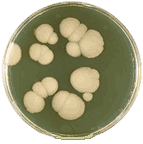Papers in the Biological Sciences
Document Type
Article
Date of this Version
2015
Citation
Hargarten JC, Moore TC, Petro TM, Nickerson KW, Atkin AL. 2015. Candida albicans quorum sensing molecules stimulate mouse macrophage migration. Infect Immun 83:3857–3864. doi:10.1128/IAI.00886-15.
Abstract
The polymorphic commensal fungus Candida albicans causes life-threatening disease via bloodstream and intra-abdominal infections in immunocompromised and transplant patients. Although host immune evasion is a common strategy used by successful human fungal pathogens, C. albicans provokes recognition by host immune cells less capable of destroying it. To accomplish this, C. albicans white cells secrete a low-molecular-weight chemoattractive stimulant(s) of macrophages, a phagocyte that they are able to survive within and eventually escape from. C. albicans opaque cells do not secrete this chemoattractive stimulant( s). We report here a physiological mechanism that contributes to the differences in the interaction of C. albicans white and opaque cells with macrophages. E,E-Farnesol, which is secreted by white cells only, is a potent stimulator of macrophage chemokinesis, whose activity is enhanced by yeast cell wall components and aromatic alcohols. E,E-farnesol results in up to an 8.5-fold increase in macrophage migration in vitro and promotes a 3-fold increase in the peritoneal infiltration of macrophages in vivo. Therefore, modulation of farnesol secretion to stimulate host immune recognition by macrophages may help explain why this commensal is such a successful pathogen.
Included in
Environmental Microbiology and Microbial Ecology Commons, Other Life Sciences Commons, Pathogenic Microbiology Commons



Comments
Copyright © 2015, American Society for Microbiology. Used by permission.